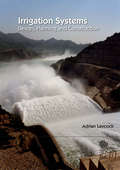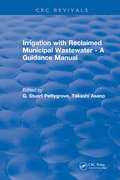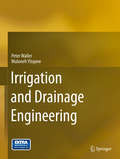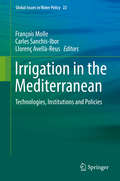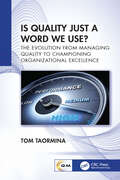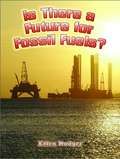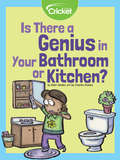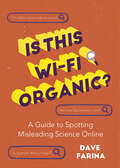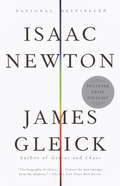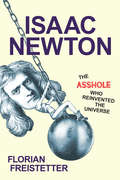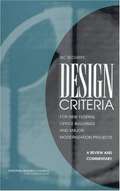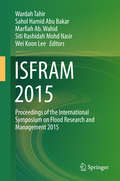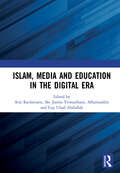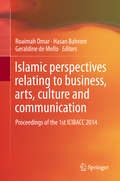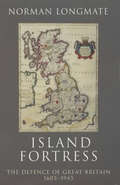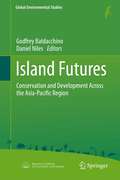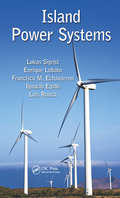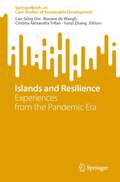- Table View
- List View
Irrigation Sustainability with Saline and Alkali Waters: Extent, Impacts and Management Guidelines
by Manzoor Qadir Paramjit S. MinhasThis book provides a practical guidance and a set of principles for improving management of saline and alkali waters and thus would be useful for different stakeholders, including agricultural students, researchers, environmentalists, and policy makers. The worldwide aggregated area with occurrence of saline and brackish groundwater is about 24 million square kilometers causing annual food losses to the extent of food requirements of 170 million people. For fostering the safe and reliable use of these waters, researchers have innovated management techniques helping sustainable irrigation with waters otherwise rated earlier as unfit. Vast pool of information has been put together in this book covering groundwater irrigation scenario and need for non-conventional waters; extent, genesis, and global distribution of saline groundwater; impacts of saline and alkali irrigation waters on soils and crops; management approaches for sustaining irrigation with typical saline and alkali ground waters for agricultural and horticulture crops; steady and non-steady state models for salt and water dynamics vis-a-vis crop responses; alternate uses of highly saline waters; water quality guidelines for irrigation under different soil and agro-climatic conditions and ultimately some researchable and policy issues for promoting irrigation with these waters.
Irrigation Systems: Design, Planning and Construction
by Adrian LaycockThe author states that contemporary thinking in irrigation engineering has benefited from the cross-fertilization of ideas from other fields, including social sciences, control, theory, the economy, and agriculture. But, he continues, that knowledge has largely been ignored by many irrigation engineers, which has led to a decrease in their involvement in development of irrigation by planners and policy makers. Laycock, a civil engineer specializing in agricultural engineering, presents new ideas on the design of canals and pipeline systems, parabolic canals, computerized design, and relevant issues relating to social conflict, management, and political thinking. Clear writing and a number of photographs and illustrations add to the book's readability.
Irrigation With Reclaimed Municipal Wastewater - A Guidance Manual
by G.Stuart PettygroveIrrigation with Reclaimed Municipal Wastewater - A Guidance Manual is for use in the planning, design, and operation of agricultural and landscape irrigation systems using reclaimed municipal wastewater. It is written for civil and sanitary engineers, agricultural engineers, and agricultural extension workers and consultants. The manual is also useful as a reference for public works officials, municipal wastewater treatment plant operators, and students at colleges and universities. The text emphasizes irrigation for the purpose of optimizing crop production; therefore, it includes detailed instruction in the calculation of crop water requirements. Furthermore, the benefits and limitations of using reclaimed municipal wastewater for agricultural and landscape irrigation are discussed, as are other topics of special interest, including water management for salinity and sodicity control, and economic and legal aspects of reclaimed wastewater irrigation.
Irrigation and Drainage Engineering
by Peter Waller Muluneh YitayewThis textbook focuses specifically on the combined topics of irrigation and drainage engineering. It emphasizes both basic concepts and practical applications of the latest technologies available. The design of irrigation, pumping, and drainage systems using Excel and Visual Basic for Applications programs are explained for both graduate and undergraduate students and practicing engineers. The book emphasizes environmental protection, economics, and engineering design processes. It includes detailed chapters on irrigation economics, soils, reference evapotranspiration, crop evapotranspiration, pipe flow, pumps, open-channel flow, groundwater, center pivots, turf and landscape, drip, orchards, wheel lines, hand lines, surfaces, greenhouse hydroponics, soil water movement, drainage systems design, drainage and wetlands contaminant fate and transport. It contains summaries, homework problems, and color photos. The book draws from the fields of fluid mechanics, soil physics, hydrology, soil chemistry, economics, and plant sciences to present a broad interdisciplinary view of the fundamental concepts in irrigation and drainage systems design.
Irrigation in the Mediterranean: Technologies, Institutions and Policies (Global Issues in Water Policy #22)
by François Molle Carles Sanchis-Ibor Llorenç Avellà-ReusMediterranean irrigation is diverse due to, among other factors, the relative importance of water in the economy of each country, varied levels of aridity, heterogeneous levels economic, social and technological levels of development, and differences in political and social organization. However, most of the Mediterranean countries face similar problems to meet their water demands because of the scarcity and variability of renewable resources, growing water requirements from non-agricultural sectors, increasing environmental concerns related to water quality and environmental degradation, a social demand for larger public participation, and important technological changes. The time has come to reconsider the “not one drop lost to the sea” philosophy of yesteryears largely and to 'live within limits'.This book focuses on eight selected countries (Tunisia, Morocco, Spain, France, Italy, Turkey, Israel and Egypt) and provides a comparative perspective that both thoroughly explores their specificities and identifies the common challenges faced by the irrigation sector in these countries. The book has been written at a critical moment, when the continued application of a supply-side water management model is revealing its unsustainable nature in numerous places; when significant technological changes are taking place in the irrigation sector; when new forms of management and governance are widely held as badly needed; and finally, when climate change is compounding many of the difficulties that have characterized irrigation policies and practices in the past decades.This complicated future context makes Mediterranean irrigation face various political dilemmas on water management, raising social tensions, triggering territorial and land conflicts, and stimulating new technological developments. This book provides a timely analysis of the particular trajectory of eight Mediterranean countries in these uncertain transformations, and attempts to identify the best strategies to avert or overcome future risks.
Is American Science in Decline?
by Yu Xie Alexandra A. KillewaldAlarmists argue that the United States urgently needs more and better-trained scientists to compete with the rest of the world. Their critics counter that, far from facing a shortage, we are producing a glut of young scientists with poor employment prospects. Both camps have issued reports in recent years that predict the looming decline of American science. Drawing on their extensive analysis of national data sets, Yu Xie and Alexandra Killewald have welcome news to share: American science is in good health. Is American Science in Decline? does reveal areas of concern, namely scientistsâ low earnings, the increasing competition they face from Asia, and the declining number of doctorates who secure academic positions. But the authors argue that the values inherent in American culture make the country highly conducive to science for the foreseeable future. They do not see globalization as a threat but rather a potential benefit, since it promotes efficiency in science through knowledge-sharing. In an age when other countries are catching up, American science will inevitably become less dominant, even though it is not in decline relative to its own past. As technology continues to change the American economy, better-educated workers with a range of skills will be in demand. So as a matter of policy, the authors urge that science education not be detached from general education.
Is Quality Just a Word We Use?: The Evolution from Managing Quality to Championing Organizational Excellence
by Tom TaorminaQuality management systems are essential for businesses to meet customer needs, ranging from product control to enterprise-wide process management. Effective management can elevate organizations to brand domination, while poor management can ruin an enterprise. This book equips quality experts with skills to champion business excellence and risk avoidance.Is Quality Just a Word We Use? The Evolution from Managing Quality to Championing Organizational Excellence explores the history and flaws of quality management, offering a career opportunity for professionals that can lead to professions as expert witnesses in products liability and organizational negligence litigation. It introduces a novel quality auditing method, focusing on forensic-level investigations and case studies to illustrate the importance of prioritizing quality in business operations.This book presents a groundbreaking model for quality professionals to drive revolutionary changes in business management, empowering them to eliminate defects and enhance their impact on business success, attracting professionals in fields such as quality assurance, quality management, risk management, and manufacturing management as well those involved in litigation.
Is Science Multicultural? Postcolonialisms, Feminisms, and Epistemologies
by Sandra HardingThis book explores what the last three decades of European/American, feminist, and postcolonial science and technology studies can learn from each other. Sandra introduces and discusses an array of postcolonial science studies.
Is That Real?: Identification and Assessment of the Counterfeiting Threat for U.S. Banknotes
by National Research Council of the National AcademiesA key mission of the Bureau of Engraving and Printing of the Department of the Treasury is the design and printing of U.S. banknotes. The BEP is responsible for producing easily recognizable currency that is difficult to counterfeit. In recent years, the bureau has recognized the modern information technology could lead to entirely new types of counterfeiting threats, and it has requested a number of studies by the NRC to assess these evolving threats. In this new request, the BEP asked the NRC to identify and evaluate significant emerging counterfeiting threats and to assess technologically feasible counterfeit-deterrent features for potential use in new designs. This first report provides an assessment of emerging threats including a wide range of digital imaging and printing techniques. It also presents an analysis of a systems approach to the counterfeiting threat. The second report will offer an evaluation of new banknote features to address these threats.
Is There a Future for Fossil Fuels?
by Ellen RodgerNatural gas, oil, and coal are finite resources, and their use contributes to deadly smog and global warming. The Future of Fossil Fuels follows the world's dependence on these resources and shows how people are working to reduce their use--and even make them more environmentally friendly!
Is There a Genius in Your Bathroom or Kitchen?
by Ellen SeidenIf you’re looking for a great invention, look no further than your bathroom or kitchen! Did you know that the first flushing toilet was invented four thousand years ago? Or that a melted chocolate bar sparked the discovery of the microwave? Learn about these great inventions and more!
Is This Wi-Fi Organic?: A Guide to Spotting Misleading Science Online
by Dave FarinaHow to separate facts from fake science in the Disinformation Age: “Cuts through the chaos . . . sure to keep you laughing while also keeping you thinking.” —Matt Candeias, PhD, author of In Defense of PlantsWe live in an era when scams, frauds, fake news, fake stories, fake science, and false narratives are everywhere. Fortunately, you don’t need a BS in Science to spot science BS. This guide from educator Dave Farina, aka YouTube’s Professor Dave, is a playful yet practical investigation of popular opinions and consumer trends that permeate our society. Shoppers insist on “organic” everything even if they’re unable to define the term. Healers and quantum mystics secure a foothold alongside science-based medicine in an unregulated and largely unchallenged landscape. Misleading marketing is used to sell you products and services that range from ineffectual to downright dangerous.With the knowledge gained from Dave Farina’s simple explanations of basic scientific principles, you can learn to spot misinformation and lies on the internet before they spot you. Learn the real science behind such semi-controversial subjects as drugs, vaccines, energy, and biotechnology—and most importantly, arm yourself with the critical-thinking skills everyone needs in a world filled with nonsense.“Scientific literacy is our best defense in an age of increasing disinformation.” —Kellie Gerardi, aerospace professional and author of Not Necessarily Rocket Science
Isaac Newton
by James GleickIsaac Newton was born in a stone farmhouse in 1642, fatherless and unwanted by his mother. When he died in London in 1727 he was so renowned he was given a state funeral--an unheard-of honor for a subject whose achievements were in the realm of the intellect. During the years he was an irascible presence at Trinity College, Cambridge, Newton imagined properties of nature and gave them names--mass, gravity, velocity--things our science now takes for granted. Inspired by Aristotle, spurred on by Galileo's discoveries and the philosophy of Descartes, Newton grasped the intangible and dared to take its measure, a leap of the mind unparalleled in his generation.James Gleick, the author of Chaos and Genius, and one of the most acclaimed science writers of his generation, brings the reader into Newton's reclusive life and provides startlingly clear explanations of the concepts that changed forever our perception of bodies, rest, and motion--ideas so basic to the twenty-first century, it can truly be said: We are all Newtonians.From the Trade Paperback edition.
Isaac Newton (SparkNotes Biography Guide)
by SparkNotesIsaac Newton (SparkNotes Biography Guide) Making the reading experience fun! SparkNotes Biography Guides examine the lives of historical luminaries, from Alexander the Great to Virginia Woolf. Each biography guide includes:An examination of the historical context in which the person lived A summary of the person&’s life and achievements A glossary of important terms, people, and events An in-depth look at the key epochs in the person&’s career Study questions and essay topics A review test Suggestions for further reading Whether you&’re a student of history or just a student cramming for a history exam, SparkNotes Biography guides are a reliable, thorough, and readable resource.
Isaac Newton School Driving: Physics & Your Car
by Barry Parker&“Wonderful . . . a great resource for automobile fans who want to understand science, and vice versa.&” —Alan C. Tribble, author of A Tribble&’s Guide to Space For some, driving is an art; for others, it&’s a science. At the Isaac Newton School of Driving, though, every car is a laboratory on wheels and every drive an exciting journey into the world of physics. In this book, physics professor Barry Parker—whose father was a car mechanic and garage owner—shows how almost every aspect of driving involves physics. A car's performance and handling relies on concepts such as force, momentum, and energy. Its ignition system depends on the principles of electricity and magnetism. Braking relies on friction—and if the brakes fail, the resulting damage, too, can be predicted using physics. Parker&’s first lesson describes the basics: speed and acceleration; why you get thrown forward while braking or outward while turning; and why car advertisements boast about horsepower and torque. He also discusses: the thermodynamics of engines, and how they can be more fuel efficientwhat friction and traction are and how they keep a car&’s tires on the road, whether it's dry, wet, or icyhow simple laws of physics enable scientists to design aerodynamic cars and high-tech steering systemsthe high-performance physics of auto racinghow traffic accidents are reconstructed by policehow chaos theory helps explain why traffic jams happenwhat cars of the future might look like, and more &“You don't need to be an engineer to read and enjoy Parker&’s often entertaining book…covers everything from the basics of engines and electronics to crashes and congestion.&” —Autoweek
Isaac Newton, The Asshole Who Reinvented the Universe: The Asshole Who Reinvented The Universe
by Brian Taylor Florian FreistetterA blunt and humorous profile of Isaac Newton focusing on his disagreeable personality and showing that his offputting qualities were key to his scientific breakthroughs.Isaac Newton may have been the most important scientist in history, but he was a very difficult man. Put more bluntly, he was an asshole, an SOB, or whatever epithet best describes an abrasive egomaniac. In this colorful profile of the great man--warts and all--astronomer Florian Freistetter shows why this damning assessment is inescapable.Newton's hatred of fellow scientist Robert Hooke knew no bounds and he was strident in expressing it. He stole the work of colleague John Flamsteed, ruining his career without a second thought. He carried on a venomous battle with Gottfried Wilhelm Leibniz over the invention of calculus, vilifying him anonymously while the German scientist was alive and continuing the attacks after he died. All evidence indicates that Newton was conniving, sneaky, resentful, secretive, and antisocial. Compounding the mystery of his strange character is that he was also a religious fanatic, a mystery-monger who spent years studying the Bible and predicted the apocalypse.While documenting all of these unusual traits, the author makes a convincing case that Newton would have never revolutionized physics if he hadn't been just such an obnoxious person. This is a fascinating character study of an astounding genius and--if truth be told--an almighty asshole as well.
Isambard Kingdom Brunel
by Robin JonesA biography of the nineteenth-century Englishman who was &“one of the most ingenious and prolific figures in engineering history&” (Nature). Civil and mechanical engineer Isambard Kingdom Brunel&’s accomplishments were extraordinary—involving the Great Western Railway, the SS Great Britain, the Clifton Suspension Bridge, prefabricated hospital buildings for use during the Crimean War, and more. Born in Portsmouth in 1806, he followed in his French father&’s professional footsteps—and went on to play a major role in the Industrial Revolution. Brunel the great engineer would habitually throw out the rule book of tradition and established practice and start again with a blank sheet of paper, taking the technology of the day to its limits and then going another mile. But there was also Brunel the visionary, who knew that transport technology had the power to change the world, and that he had the ability to deliver those changes. Finally, there was Brunel the artist, who rarely saw technology as just functional, and strove to entwine the fruits of the Industrial Revolution with the elegance and grace of the neoclassical painter. His bridges, tunnels and railway infrastructure have entered a third century of regular use, and the beauty of their design and structure has rarely been equaled. The three decades from the 1830s to the 1850s saw an explosion of technical excellence, and it was Brunel who in so many cases lit the blue touch paper. He did not always get it right the first time, and it was left to others to reap the fruits of his many labors. Nevertheless, his actions fast-forwarded the march of progress by several decades. This biography tells his impressive story. Includes color photographs
Isc Security Design Criteria For New Federal Office Buildings And Major Modernization Projects: A Review And Commentary
by Committee to Review the Security Design Criteria of the Interagency Security CommitteeInformation on the Isc Security Design Criteria For New Federal Office Buildings And Major Modernization Projects
Isfram 2015
by Wardah Tahir Sahol Hamid Abu Bakar Marfiah Ab. Wahid Siti Rashidah Mohd Nasir Wei Koon LeeThis book focuses on international research in flood-related areas and sustainable management. It consists of a compilation of innovative works, demonstrating best practices in flood management and recommend flood solutions. The selected papers cover the fundamentals and latest advances in the area, complete with illustrations, diagrams and tables. These proceedings serve as a source of information and state-of-the-art technology in managing floods to improve quality of life.
Islam, Media and Education in the Digital Era: Proceedings of the 3rd Social and Humanities Research Symposium (SoRes 2020), 23 – 24 November 2020, Bandung, Indonesia
by Atie RachmiatieThe proceedings of the Social and Humanities Research Symposium (SoRes) shares ideas, either research results or literature review, on islam, media and education in the digital era. Some recent issues consists of innovative education in the digital era, new media and journalsm, islamic education, human wellbeing, marketing and fintech in terms of islamic perspective, economic welfare, law and ethics. It is expected that the proceedings will give new insights to the knowledge and practice of social and humanities research. Therefore, such parties involved in social and humanities research as academics, practitioners, business leaders, and others will acquire benefits from the contents of the proceedings.
Islamic perspectives relating to business, arts, culture and communication
by Roaimah Omar Hasan Bahrom Geraldine De MelloThis timely book explores how the Malays and Muslims in general are faced with challenges in the fields of business, economy and politics, in the modern era of globalisation. These research findings can help the Muslim community to enhance international integration, particularly in Malaysia and Southeast Asia. In this work, scholarly and expert authors explore Islamic perspectives on communication, art and culture, business, and law and policy. They respond to the need to uphold and strengthen the culture, arts and heritage of the Malays. Readers are invited to explore the challenges for the Malay and Muslim world and to evolve strategies to ensure competitiveness, dynamism and sustainability. Topics such as Islamophobia, drug trafficking, savings behaviours and the role of social media are addressed. These reviewed papers were presented at the International Conference on Islamic Business, Art, Culture & Communication 2014, held in Melaka, Malaysia. They have the potential to strengthen aspects of Islamic economy and leadership, if translated into action plans. This book represents essential reading for scholars of Islamic studies and will be of interest to those examining Southeast Asia and the Malay world.
Island Fortress: The Defence of Great Britian 1606-1945
by Norman LongmateThe British Isles, it is often believed, have not been invaded for nearly a thousand years. In fact, as Norman Longmate reveals in this highly entertaining book (the successor to his acclaimed Defending the Island), foreign soldiers have landed on British soil on many occasions.In this definitive study of a long-neglected subject Norman Longmate make constant use of original sources, including contemporary eyewitness accounts. These are woven into an enthralling narrative, packed with fact - about weapons, ships, armies and fortresses - spiced with anecdote, and ranging over international and political as well as military and naval history. The result is above all an exciting story, which shows how, against all the odds, the British people managed to retain their freedom from the days of James I to those of George VI.
Island Futures
by Daniel Niles Godfrey BaldacchinoIslands face one of the most pressing issues of our time: how to balance ecological integrity with economic development and collective quality of life, including the need for social and conservation space. Islands are sites of rich and varied human and ecological diversity, but they are also often characterized by narrow resource bases and dependency on links to the outside world, and by their limited ability to determine the actual character of those links. This volume reviews the challenges of island development and conservation in the Asia-Pacific region. With emphasis on nature reserves and UNESCO World Heritage sites, chapters describe the benefits, barriers, and potential pitfalls in preserving such sites, managing biota, and attracting and controlling tourism. The book also provides a provocative challenge to move beyond the typical concerns of "sustainability" to the more holistic concept of "futurability", or "future potential" for convivial human-environmental interactions.
Island Power Systems
by Lukas Sigrist Enrique Lobato Francisco M. Echavarren Ignacio Egido Luis RoucoA major concern of island power systems is frequency stability. A power system is said to be frequency stable if its generators are able to supply their loads at a frequency within acceptable limits after a disturbance. Frequency instability occurs if load-generation imbalances are not corrected in appropriate manner and time. Since island power systems are more sensitive to frequency instability than large ones due to the smaller number of generators online and the lower inertia, they require a larger amount of primary reserve per generator. This book provides a worldwide overview of island power systems, describing their main features and issues. Split into two parts, the first part examines the technical operation, and in particular, frequency stability of island power systems and its technical solutions, including more efficient underfrequency load-shedding schemes. The chapters explore both conventional and advanced load-shedding schemes and consider the improvement of these schemes by making them more robust and efficient. Advanced devices are modelled and analyzed to enhance frequency stability and reduce the need for load shedding. In the second part, the economic operation of island power systems is explored in detail. For that purpose, regulations and economic operations (centralized vs. market scheme) are reviewed by the authors. The authors discuss models for renewable energy sources and for advanced devices and systems such as demand-side management, energy storage systems, and electric vehicles. This book will be critical reading to all researchers and professionals in power system planning and engineering, electrical/power delivery, RES and control engineering. It will also be of interest to researchers in signal processing and telecommunications and renewable energy, as well as power system utility providers.
Islands and Resilience: Experiences from the Pandemic Era (SpringerBriefs on Case Studies of Sustainable Development)
by Can-Seng Ooi Roxane De Waegh Cristina Alexandra Trifan Yunzi ZhangThis book explores island resilience and how island communities come together to achieve wellbeing, have agency over their future and resist ongoing neo-colonialism during disruptive events such as COVID-19 and the increasing threats of climate change. This collection provides examples of lived experiences and the responses of island communities, many of them based in tourism-reliant locations. These examples are based on intensive research by a team of diverse academics and practitioners. The chapters offer case studies that interrogate theories related to resilience, wellbeing and social inclusion and provide cutting-edge insights that demonstrate the multifaceted complexity of island resilience.This book examines the islands, their developing economy and social development themes. It is relevant for academic researchers, students, and practitioners interested in the multiple components that contribute to the resilience of island communities, including community development, economic development, tourism, disaster response, community wellbeing, social justice, globalisation, decolonisation, and neoliberal governance in island communities. As many of the island economies examined are also developing island-states, this volume is also essential to scholars investigating economies in transition. The collection is truly interdisciplinary and offers state-of-the-art knowledge on island communities and their resilience.

